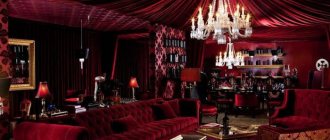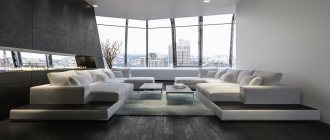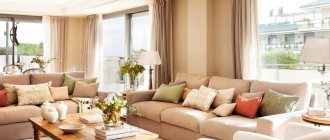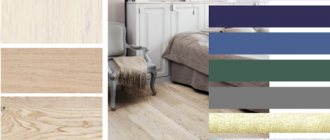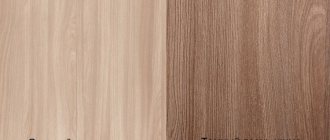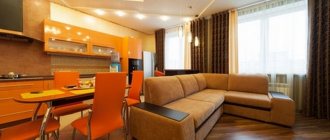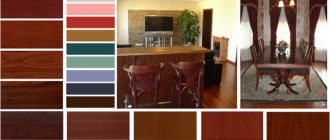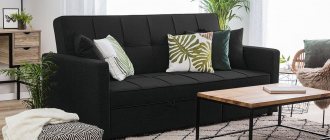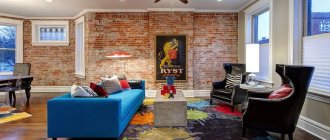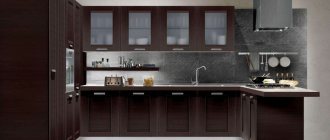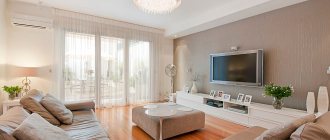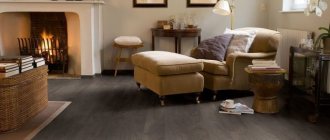Natural wood in the interior of a home is always expensive and prestigious. Especially when it comes to exotic woods such as wenge.
This is the name of tropical trees of the legume family, whose homeland is Central Africa. There are 25 known varieties of it. This name was coined by European colonists who discovered this breed at the end of the 19th century. The tree grows in countries such as Cameroon, Congo, and Ecuador. The height of the trees does not exceed 20 meters, the thickness of the trunk is no more than 1 meter. The completely smooth bark of the tree is poisonous; when cut, a milky sap of gray or pinkish-gray color is released. The tree family has a rich palette of brown shades. The range is from deep brown, almost black to dark burgundy and purple. Now this name has become a household name, not only the tree is called this way, but also a diverse palette of its shades.
The color of the wood is uneven: darker in the middle, lighter under the bark. Among the large variety, it is impossible to find two identical trees. Its shades depend on the composition of the soil where the tree grows, the age of the tree itself, the weather and neighboring plants. The high cost of wenge wood is ensured not only by its noble shades, but also by its high performance qualities:
- the wood is quite durable and resistant to mechanical damage;
- moisture resistant;
- is not susceptible to mold and is not afraid of parasites;
- durable and versatile;
- easy to process.
The high cost is compensated by a long service life. The use of this unique wood in the interior is always a sign of luxury and high status.
What color is this?
Like oak or walnut, wenge is a type of wood obtained from the African tree of the same name.
Natural wood of this species has gained popularity not only due to its beautiful dark tone and pronounced texture (brown with black veins looks very decorative), but also due to its properties. The material is very dense, durable, impact resistant. Not subject to bending, rotting, infection by fungus and mold. However, complex processing and the extremely low number of remaining trees make natural material extremely expensive and practically inaccessible.
But manufacturers were able to adapt and today offer an imitation of wenge shade in 2 options:
- Lamination. Classic laminated chipboards, coated with a film of a suitable color and texture.
- Dye. Natural wood of any other species is coated with a special paint to achieve similarity to the original source.
In the photo wenge color in the kitchen
What shades of wenge are there?
Unlike oak, which can be milky, bleached, rustic, clear, natural, antique, tobacco, the wenge shade usually does not have additional names and is designated in catalogs by one word. At the same time, from different manufacturers, the wenge color looks different:
- Melinge. Deep dark brown with cool undertones achieved through gray flecks.
- Tsavo. Warm chocolate shade.
- Aruba. A rich color scheme that fades into burgundy.
- Linum. The lightest tone with the finest veins.
- Magic. Neutral dark shade.
Take the choice of wenge color in the interior responsibly: the options for combinations with other tones depend on the saturation and temperature.
Wenge furniture and light wallpaper in the living room design
When choosing wallpaper, consider what colors wenge goes perfectly with. In this case, give preference to the following colors:
- light pink;
- blue;
- turquoise;
- green;
- red;
- yellow;
- pistachio;
- orange.
From the entire range given above, choose the one that is most comfortable for you.
What colors does it go with?
Since wenge-colored furniture is almost black, this difficult shade works in much the same way. Wenge goes well with almost the entire color palette.
The first contender to pair with the wenge shade is white. Tones in contrast look bright, but restrained. Gray can be used as an additional light shade. True, in the case of melinge, the combination may become too faded - you will need to add bright accents.
Harmonizing duets are obtained by mixing wenge color with light, warm companions: beige, milky, sand. Most often, this combination is used when creating a classic interior with wenge, because is tested and working.
As for black, you shouldn’t overdo it: the maximum is to add small details to furniture in wenge color on a light background.
In the photo there is a combination with red
Don’t neglect the color scheme: wenge color in the interior looks equally good with pastel and bright colors. Cold melinge is usually combined with blue, blue, and green. Yellow, orange, and red suit warm colors. The complex aruba will sparkle in a new way next to purple.
Origin story
African rosewood has been known since ancient times, when boats, rafts and houses were made from the durable material. This color appeared in the interior much later, already in the 21st century. The thing is that until recently, dark floors and furniture were considered bad manners, so there was no need to invent a new shade.
The wenge shade began to be used in the interior relatively recently.
From time immemorial, natural rosewood wood has been considered very expensive because of its universal qualities: resistance even to severe mechanical damage, deformation and moisture. The material is durable and versatile in its use, which justifies the price.
Furniture made from natural wenge is very expensive.
Application options
The use of wenge shade is extensive: furniture is most often made in wenge color, but it is also used in the decoration of walls, floors, ceilings, in the manufacture of accessories and even textiles.
Wenge colored furniture
Wenge furniture in the interior is an indicator of status. Install in any room - living room, bedroom, kitchen, bathroom, nursery, hallway.
Coffee tables, walls, and cabinets are made for the hall. In a kitchen in wenge there can be either the entire set or part of it - the lower tier is made dark, the upper - colored or light. Or they are used exclusively in the dining area: in the form of a table with chairs or a sofa.
The photo shows a classic milky brown kitchen
The bedroom can be furnished in a shade from floor to ceiling (wardrobe, bed, nightstands), or it can be used to a limited extent as an accent. A freestanding chest of drawers, for example, will draw attention to the desired area.
Interior items can be either 100% dark or mixed: for example, wenge cabinets, facades - light oak or maple. The combination of white gloss and dark wood looks modern.
Decor and accessories
Decorative elements will emphasize good taste, but will not draw the attention of guests. These could be mirrors, small coffee tables, picture frames. Carved partitions or screens that zone the space look no less impressive.
Curtains and other textiles
Of course, calling the fabric wenge is not entirely correct: this concept means the dark brown color of the textile.
Curtains are good on their own, but they look best in combination with cream, milky, olive, gray, and blue shades. The same goes for pillows and blankets on the sofa - if they are all chocolate, the composition will turn out too bland.
Doors and windows
Wenge-colored doors are a universal option for various styles. In a classic style, for example, beautiful relief canvases with bas-reliefs would be appropriate. In modern - models with straight lines, clear shapes, in minimalism - dull.
Dark windows are an excellent alternative to regular white double-glazed windows. They look more expensive and go well with interior doors.
Ladder
Owners of country houses face a difficult choice: what to make a staircase from? Regular wood is not always suitable, but dark African wood is more versatile. It looks equally good in combination with carved balusters and glass railings.
Main characteristics
Wenge also looks very stylish, which is why its distinctive pattern is so popular in today's interior design market. Its beautiful wavy pattern is similar to the color of the feathers of feathered partridges.
This effect is evident in both the main Wenge cuts and the partitions, where the contrast of the wood between the dark and medium brown grains shows up in higher contrast.
Material characteristics:
- Color/Appearance: The heartwood is medium brown, sometimes tinged with reddish or yellowish, with almost black stripes. When finishing (especially with oil) the wood can become almost black.
- Grain/Texture: The grain is straight, with a very coarse texture. Low natural shine.
- Granularity: diffusely porous, large and very large, but rare pores without a specific location. Sometimes there are dark brown inclusions; the middle rays, not visible without a lens, are at an average distance from each other.
- Durability and stability. Wenge is an extremely heavy, dense material. These characteristics give the material strength, which explains why Wenge is so popular for flooring and furniture. Wood stands the test of time.
- Laconic appearance. Has straight lumber to work with and greatly simplifies construction and design, making it easy to work with when it comes to appearance.
- Rot Resistance: Very durable, pest resistant.
- Labor intensive: difficult to process by hand or machine. Blurres the edges of the tool. Sanding occurs unevenly due to differences in density between light and dark areas.
Very splintery - care should be taken when handling unfinished wood with bare hands as splinters have an increased risk of infection.
Very large pores may be difficult to fill and are not suitable for applications where a perfectly smooth/even finish is required.
- Odor: Wenge has a weak, slightly bitter odor when working.
- Allergies/Toxicity: Although severe reactions are quite rare, inhalation of wood dust from this tree has been reported to cause a central nervous system reaction, abdominal cramps, skin irritation, eye irritation, and is a sensitizer.
In addition, splinters from it tend to take longer to heal and are also more likely to affect a larger area than splinters from other breeds.
- Pricing/Availability: Available in wide planks and veneer sheets. Prices are high and are likely to remain so as supplies dwindle.
- Sustainability: This timber species is not listed on the CITES appendix but is on the IUCN Red List. It is listed as threatened due to a decline of more than 50% over the last three generations, caused by the decline of its natural range and exploitation.
A wood with excellent strength and hardness properties and is also dark enough to be used as a substitute for ebony.
Common uses: veneer, paneling, furniture, clocks, figurines and other decor. As well as finishing materials, doors, door handles, musical instruments. Noble dark shades can not only emphasize the geometry of the room, but also bring luxury and nobility to the image of the interior.
Wenge has a visual impact on others due to its chocolate brown color. It also provides great contrast when designing spaces alongside lighter, more contrasting wood species.
How does it look when finished?
When carrying out major repairs and changing flooring, many turn to wenge shade. A dark floor is a noble, aesthetic, although not very practical option.
But if you have a robot vacuum cleaner in your apartment or you don’t mind cleaning once every couple of days, there shouldn’t be any problems. Of all the finishing materials, laminate, linoleum, and quartz vinyl are considered the easiest to maintain.
In the photo wenge color in the wall decoration
In addition to wenge flooring in the interior, walls are often decorated with panels of this shade. The design looks good behind the bed or opposite the sofa - as a base for a TV with an audio system.
Floors and walls are not the only option for using wenge color. Dark wood slats, for example, are often used to decorate the ceiling: the decor looks good against a white background.
In the kitchen, tone is used for countertops and backsplashes. They can even be made in one color - there is a large selection of MDF panels on the market, decorated with the same film as the work surfaces.
Floor
The unique palette and suitable texture of the material have made wenge color perhaps the most popular among modern floor coverings. Wealthy people choose natural parquet as a material. Affordable laminate is much more in demand, but for wenge it must be of high quality.
Living rooms always look great with this flooring. Dark color makes a large room feel deeper and fuller. In small living rooms, lighter varieties, such as bleached oak, look organic. The red floor is exotic, and the most popular one is deep burgundy.
Wenge laminate is valued not only for its aesthetic appeal, but also for practical reasons. Scratches or other minor damage that inevitably appear during use are almost invisible on it. It is easy to care for, high-quality types last a long time, even in the kitchen.
The only disadvantage of wenge parquet or laminate, especially dark ones, is that dust is immediately visible on them, but the problem can be solved by simple cleaning.
What styles is it suitable for?
Unlike red wood shades, such as beech, alder, and cherry, almost ebony is more versatile. If red is appropriate only in classic decoration, then dark brown tones are also suitable for modern trends.
Example: hi-tech. Surrounded by glass and metal, wenge looks appropriate; the main thing is to select interior items in a minimalist design.
Pure minimalism also chooses this one from all types of wood: neutral, but not black, ideal for decorating large surfaces.
When combining the incongruous (fusion), individual chocolate items will easily find their place.
What does it look like in the interior?
We have already mentioned that wenge can be used in absolutely any room. But you should remember the rule: the abundance of dark details will make the compact space even smaller. So in small rooms, use with caution and only in combination with a light palette.
Kitchen
Happy owners of large kitchens can afford a rich corner or U-shaped set with upper cabinets, pencil cases, columns, and an island. The excess of deep tone is compensated by light finishing and decor.
Important! Handles are a must for facades - thanks to them, there will be much fewer fingerprints on the doors.
The photo shows a combination of wenge color and concrete
If the kitchen is less than square meters, you need to choose what is more important to you - visual space or dark furniture. To preserve free space, at least visually, only the bottom row of cabinets is made in wenge or used locally: for countertops, chairs, and a dining table.
Living room
The rules are the same with the hall: in a large room, the entire furnishings can be in dark wood, in a small room - only small details in a wenge shade.
When choosing a TV console or a wall with many shelves and drawers, keep in mind: dust is clearly visible on the surface and you will have to wipe it 2-3 times a week. Therefore, it is better to give preference to closed storage systems.
If you don't like the rich colors of your furniture, use the color on the floors or walls.
Bedroom
A few years ago, bedroom sets with the addition of a milky shade were popular. Today they look outdated, so if you want all the furniture in one color and style, go completely dark. And to reduce bulkiness, choose a minimalist design. Light walls and floors, white or cream decor, and textiles will help make the atmosphere more comfortable.
Hallway
If the living room is the heart of the house, then the hallway is its face. The thing that is present in any entrance group is a door. Its interior design can be anything: it’s good if it harmonizes with the interior openings and is made in wenge.
The same furniture is best suited to the coffee front door. Built-in models will not look bulky, so it is better to make the cabinet to order according to an individual size.
Set
The composition of wenge furniture is no different from any other style: the same wall, slide, display case, sofa, table, armchairs. However, due to the nature of the structure of wood, there are several points that are worth considering.
A dark wall for the living room should not be too bulky so as not to overload the interior, so drawers, glass and plastic are welcome in the decor. For example, frosted glass facades on wall doors. This gives lightness and makes the furniture more modern.
The gloss of the open part of the display case will balance the matteness of the dark base. This contrast is simply elegant.
Small living rooms can be adequately decorated with modular furniture: it can be arranged arbitrarily, making the most of all the space. If there is very little space, a wall is selected from the entire set as the most practical option. If you want to display beautiful objects, you can install a compact display case for them on the wall.
